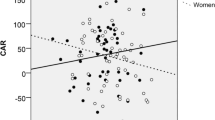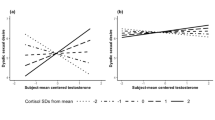Abstract
Endocrine functioning in sadists, nonsadistic sexual aggressives and criminal controls was examined in two studies. In Study 1 baseline values for 8 hormones and 2 indices of free testosterone were compared. There were no statistically significant group differences, although some cases showed abnormalities. In Study 2, the ACTH test was performed. The groups did not differ in the test results but sexual aggressives had significantly lower baseline values of DHEA-S than controls. The results could not be explained by group differences in alcohol or drug abuse. If the endocrine system plays a primary role in the etiology of sexually aggressive behavior, that role still remains to be characterized and clarified.
Similar content being viewed by others

References
Andreyko, J.L., Bhavnani, B.R., Nisker, J.A., Walker, W.H.C., & Woolever, C.A. (1986). Role of serum androgens and sex hormone binding globulin capacity in the evaluation of hirsutism in women.Clinical Biochemistry, 19, 58–61.
Anonymous (1983).SPSSX user's guide. Chicago: McGraw-Hill Book Co.
Bain, J. (1987). Hormones and sexual aggression in the male.Integrative Psychiatry, 5, 82–93.
Bain, J., Langevin, R., Dickey, R., & Ben-Aron, M. (1987). Sex hormones in murderers and assaulters.Behavioral Science & the Law, 5, 95–101.
Carter, G.D., Holland, S.M., Alaghband-Zadeh, J., Rayman, G., Dorrington-Ward, P., & Wise, P.H. (1983). Investigation of hirsutism: testosterone is not enough.Annals of Clinical Biochemistry, 20, 262–263.
Doering, C.H., Brodie, H.K.H., Kraemer, H., Becker, H., & Hamburg, D.A. (1974). Plasma testosterone levels and psychologic measures in men over a 2 month period. In R.C. Friedan, R.M. Richart, R.L. Vaderviele, & L.D. Stern (Eds.)Sex differences in behavior. New York: Wiley Co.
Doering, C.H., Brodie, H.K.H., Kraemer, H., Moos, R.H., Becker, H.B., & Hamburg, D. (1975). A negative affect and plasma testosterone: A longitudinal human study.Psychosomatic Medicine, 37, 484–491.
Freund, K., Langevin, R., Satterberg, J., & Steiner, B. (1977). Extension of the gender identity scale for males.Archives of Sexual Behavior, 6, 507–519.
Gaffney, G.R., Berlin, F.S. (1984). Is there hypothalamic-pituitary-gonadal dysfunction in pedophilia? A pilot study.British Journal of Psychiatry, 145, 657–660.
Hucker, S., Langevin, R., Dickey, R., Handy, L., Chambers, J., & Wright, S. (1988). Cerebral damage and dysfunction in sexually aggressive men.Annals of Sex Research, 1, 33.
Kreuz, L.E., & Rose, R.M. (1972). Assessment of aggressive behavior and plasma testosterone in young criminal population.Psychosomatic Medicine, 34, 321–332.
Langevin, R., Bain, J., Ben-Aron, M.H., Coulthard, R., Day, D., Handy, L., Heasman, G., Hucker, S.J., Purins, J.E., Roper, V., Russon, A.E., Webster, C.D., & Wortzman, G. (1985). Sexual aggression: constructing a predictive equation. In R. Langevin (Ed.)Erotic Preference, Gender Identity, and Aggression in Men. Hillsdale, New Jersey: Lawrence Erlbaum Associates.
Langevin, R., Handy, L., Paitich, D., Russon, A.E. (1985). A new version of the Clarke Sex History Questionnaire of Males. In R. Langevin (Ed.)Erotic preference, gender identity, and aggression in men: Hillsdale, New Jersey: Lawrence Erlbaum Associates.
Langevin, R., Paitich, D., & Russon, A.E., (1985). Are rapists sexually anomalous, aggressive, or both? In R. Langevin (Ed.)Erotic preference, gender identity, and aggression in men. Hillsdale, New Jersey: Lawrence Erlbaum Associates.
Mendelson, J.H. (1977). Endocrines and aggression.Psychopharmacology Bulletin, 13, 22–23.
Meyer-Bahlburg, H.F., Nat, R., Boon, D.A., Sharma, M., & Edward, J.A. (1974). Aggressiveness and testosterone measures in man.Psychosomatic Medicine, 36, 269–274.
Monti, P.M., Brown, W.A., & Corriveau, D.P. (1977). Testosterone and components of aggressive and sexual behavior in man.American Journal of Psychiatry, 134, 692–694.
Nanjee, M.N., & Wheeler, M.J. (1985). Plasma free testosterone -is an index sufficient?Annals of Clinical Biochemistry 22, 387–390.
Persky, H., O'Brien, C.P., Fine, E., Howard, W.J., Khan, M.A., & Beck, R.W. (1977). The effect of alcohol and smoking on testosterone function and aggression in chronic alcoholics.American Journal of Psychiatry, 134, 621–625.
Persky, H., Smith, K.D., & Basu, G.K. (1971). Relation of psychologic measures of aggression and hostility to testosterone production in man.Psychosomatic Medicine, 33, 265–277.
Rada, R.T., Laws, D.R., & Kellner, R. (1976). Plasma testosterone levels in the rapist.Psychosomatic Medicine, 38, 257–268.
Rada, R.T., Laws, D.R., Kellner, R., Stivastava, L., & Peake, G. (1983). Plasma androgens in violent and nonviolent sex offenders.Bulletin of the American Academy of Psychiatry and the Law, 11, 149–158.
Selzer, M. (1971). The Michigan Alcoholism Screening Test: The quest for a new diagnostic instrument.American Journal of Psychiatry, 127, 1653–1658.
Author information
Authors and Affiliations
Rights and permissions
About this article
Cite this article
Bain, J., Langevin, R., Dickey, R. et al. Hormones in sexually aggressive men. Annals of Sex Research 1, 63–78 (1988). https://doi.org/10.1007/BF00852883
Issue Date:
DOI: https://doi.org/10.1007/BF00852883



